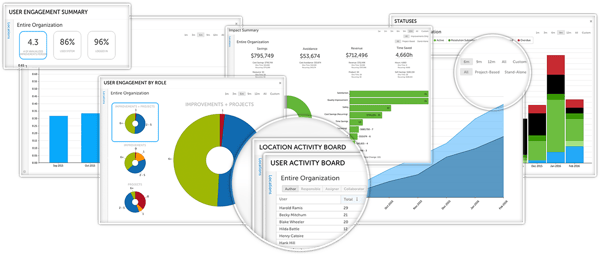 Many of the people who come to us to talk about our Lean improvement management software are not implementing an improvement program for the first time. In fact, in many cases, the very reason they are turning to us is that previous attempts to implement Lean project management have been disappointing.
Many of the people who come to us to talk about our Lean improvement management software are not implementing an improvement program for the first time. In fact, in many cases, the very reason they are turning to us is that previous attempts to implement Lean project management have been disappointing.
Here are our best tips for avoiding the common problems that lead to sub-par results.
Tip #1: Make sure everyone understands what Lean project management is and what it isn’t.
Scores of books have been written about the Lean business management approach, but not every executive who starts a Lean initiative has a full grasp of the principles of Lean. Some people get excited about Lean’s ability to eliminate waste and stop there. But, reducing waste is not the same as “doing more with less.” The goal of Lean is to create an unimpeded flow of value to the customer, not to reduce resources in a way that makes it more difficult for employees to do their work.
Lean project management initiatives that are all about cost-cutting without respect to customer value are unlikely to thrive. That’s why value stream mapping is such an important part of the Lean process. When you can see a direct path between any process or activity and something that is of value to the customers, it becomes apparent what can be eliminated and what needs to be improved.
Rather than focusing solely on cost and financial initiatives, leaders do better when they ask employees what changes would empower them to do their work more efficiently, successfully, and safely. This focus encourages engagement, while also turning up ideas that will inevitably improve the bottom line.
Check out this company's "What Bugs You" program for an idea of how to get started, the right way.
Tip #2: Get plenty of executive support.
Lean management rarely succeeds in a vacuum, but it is remarkably effective in organizations where continuous improvement is a core value. That means that leaders must provide the necessary support and resources and set a good example. It is also essential to recognize and reward the people who are committed to the approach. While improvements can be driven from the bottom-up, Lean leadership starts at the top.
Every company has a culture, whether leaders are purposeful about it or not. It is the responsibility of leaders to create an environment in which employees feel comfortable expressing their ideas for improvement.
Tip #3: Use Standard Work.
There are many Lean tools and techniques that may or may not make sense for your organization. You can choose the ones that work best for you, but Standard Work is a must.
Standard work is the documented best practice for any task or process. It is the baseline from which improvement can be measured. When every operator does the same task the same way, you can identify potential improvements and measure the results of any change.
Tip #4: Leverage supporting technology.
Many Lean project management techniques can be applied without improvement software, but it is more difficult to spread and sustain Lean without a platform for doing so. When all Lean projects are managed in an online, accessible solution built for the purpose, the organization creates one version of the truth. Leaders can get a quick insight into the health of Lean and follow individual projects to their conclusion. The best solutions provide notifications and alerts so that progress doesn’t stall. Best of all, the immediate and long-term impact of Lean projects can be calculated and shared.
Lean software is also an effective way to encourage and support cross-functional collaboration. Many of the most complex processes cross multiple functional areas, so seamless access to data and communications is a must.
Another huge advantage to using software to support Lean is that the platform becomes a repository of knowledge. Before beginning a new project, users can search what’s been done in the past to find any lessons that might improve the new project’s results.

Tip #5: Develop a common language for Lean.
Every organization is different, and Lean is used in every industry from healthcare to construction, so naturally, the language used to describe Lean projects varies widely. What’s important is that your team has a common way to describe the elements of improvement work and talk about ongoing projects. Ideally, these terms would be used uniformly across the organization. Lean software is also helpful in this regard.
Tip #6: Share results and impact widely.
Speaking of sharing, another misstep we see is the failure to share the results of successful Lean projects with the entire organization. There is a snowball effect with positive change. Once one team or functional area sees another achieve good results, they want to get in on the action as well. When individual employees are recognized for their efforts, not only are they likely to continue to be engaged in Lean projects, their peers are as well.
When considering the impact of Lean, be sure to look at both financial and non-financial factors. Cost savings are great, but so are increased employee retention improved customers satisfaction, fewer accidents, and shorter cycle times.
Tip #7: Provide extensive training on Lean tools and techniques.
When Lean project management is first introduced in an organization, we see leaders and managers provide different levels of training. Some simply announce that Lean is a new way and hope folks figure it out, while others spend more time and effort. Obviously, the latter is the most successful. If your team is going to use Lean tools like Kanban guides, huddle boards, DMAIC, and Kaizen events, it’s imperative that everyone knows how to use and manage them effectively.
Sometimes, even leaders who do an excellent job of training the team on Lean at the outset, don’t have a good plan for introducing new employees to the approach or keeping everyone’s skills fresh. It is most effective to have regular Lean training opportunities and to make continuous improvement part of your new employee onboarding process.
Tip #8: Align Lean projects with the broader strategy.
Our customers who have had the most success at aligning the entire organization from the C-suite to the front lines have used a technique called strategy deployment (sometimes called Hoshin Kanri). They identify the most important strategic goals for the organization, then cascade them down to individual objectives. Leaders regularly revisit the strategy and make adjustments as needed. Lean projects are, therefore, in step with the strategy, and everyone moves in the same direction.
The benefits of the Lean approach to project management are significant enough to be worth the effort to overcome these common pitfalls. You’ll enjoy less waste, happier customers, and more engaged employees.




Add a Comment